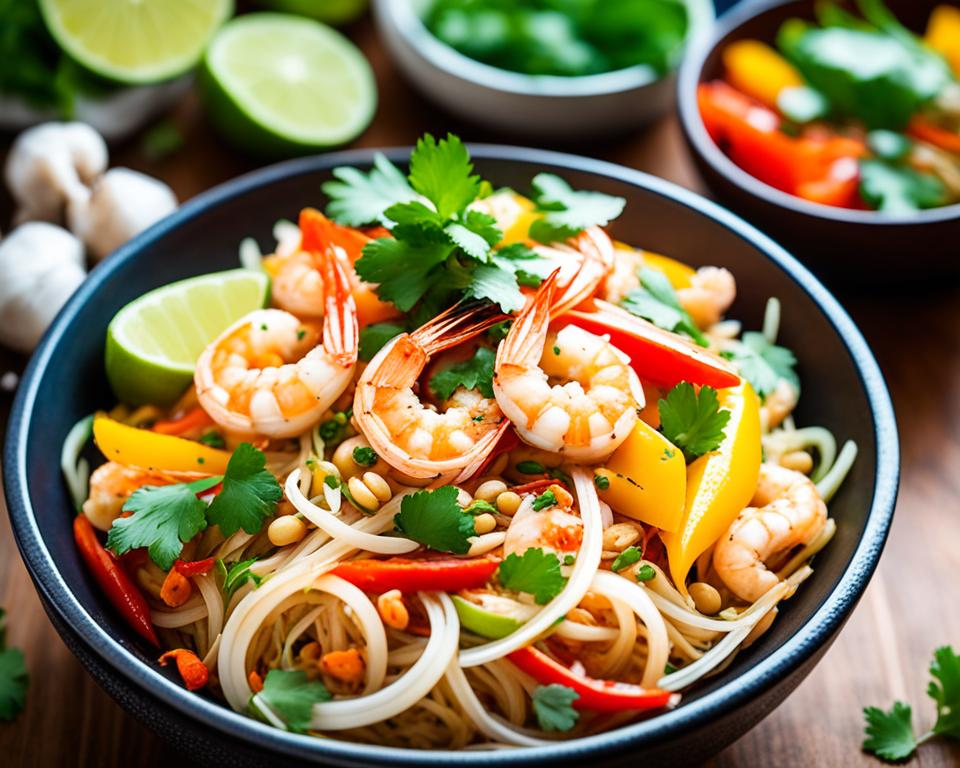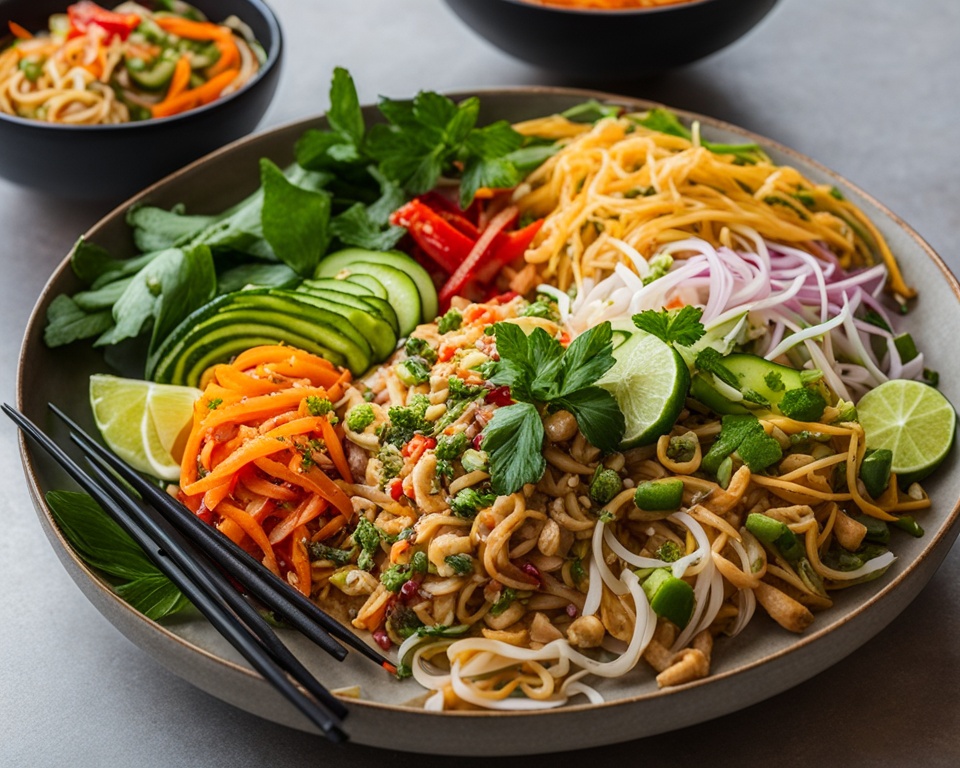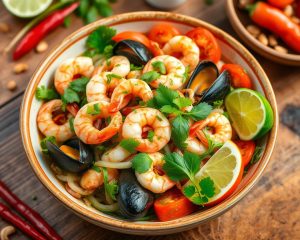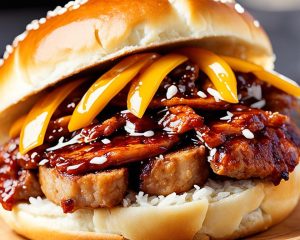Delicious Pad Thai Rice Noodles: Easy Recipe Tips

Embark on a culinary adventure with pad thai, Thailand’s beloved national dish. It’s a blend of sweet, sour, and savory tastes, making it a favorite. This guide is for both seasoned Thai cuisine lovers and newcomers, offering all the tips to cook a perfect pad thai at home.
This dish includes key ingredients and cooking methods that are essential. You’ll feel like you’re in Bangkok with each bite. Get ready to enjoy the authentic taste of this popular Thai dish.
Read more interesting information at ::googrekas
What is Pad Thai?
Pad thai is a beloved Thai noodle dish. It has spread around the world from Thailand’s central region. This stir-fried meal is famous for its mix of sweet, sour, and savory tastes. It’s a top pick for those exploring new foods.
Origins of Thailand’s National Dish
In the 1930s, Thailand worked to make pad thai stand out. It was part of a plan to join the country’s many food traditions. Since then, pad thai has grown, with each place and home adding its own twist while keeping its heart the same.
Key Ingredients in Authentic Pad Thai
- Rice stick noodles: Essential for pad thai, these noodles soak up the flavors perfectly.
- Shrimp: A classic choice, shrimp brings a nice sweetness and bite.
- Bean sprouts: They add a crunchy, fresh element to the dish.
- Peanuts: Chopped peanuts give a nutty taste and a bit of richness.
- Pad thai sauce: This sauce, made from tamarind, fish sauce, and sugar, ties everything together.
“Pad thai is a masterpiece of tastes, joining key ingredients in a memorable way.”
A great pad thai is all about balance. The noodles soak up the sauce’s tangy, sweet, and salty flavors perfectly.
Why Choose Rice Stick Noodles?
For the classic Thai dish pad thai, the type of noodles matters a lot. The top pick for authentic pad thai is rice stick noodles, known as “sen chan”. These noodles, made from rice flour, have a unique texture. They absorb the dish’s flavors perfectly.
Rice stick noodles are special because they’re gluten-free. This makes them great for people with dietary needs. Unlike noodles made from wheat, these noodles work for many diets.
What’s more, rice stick noodles add to the flavors of pad thai. They help bring out the dish’s sweet, sour, and savory tastes. This creates a perfect balance of flavor and texture.
Versatility of Rice Noodles
Rice stick noodles aren’t just for pad thai. They are key in many Asian dishes. You can use them in stir-fries, soups, cold salads, and spring rolls. Their adaptability is perfect for trying new recipes at home.
| Benefit | Explanation |
|---|---|
| Gluten-free | Rice noodles are ideal if you need to avoid gluten. They are naturally gluten-free. |
| Flavor Absorption | Rice noodles soak up the rich flavors of pad thai well. This creates a tasty balance. |
| Versatility | You can use rice noodles in a variety of Asian meals. They work in stir-fries, soups, salads, and rolls. This makes them a great pantry item. |
To sum up, rice stick noodles are perfect for pad thai. Their special texture enhances the dish’s flavors. They are gluten-free and versatile, making them great for any kitchen. Whether you’re cooking at home or catering to special diets, rice stick noodles are a smart choice.
Preparing the Pad Thai Sauce
The pad thai sauce is key to making this Thai dish taste amazing. It needs a mix of sweet, sour, and salty flavors in the right balance. Getting this balance right makes your pad thai taste real, like you’re eating in Thailand.
Essential Pad Thai Sauce Ingredients
The pad thai sauce needs few but important ingredients:
- Fish sauce – This condiment adds a lot of depth and bold taste to the sauce.
- Tamarind paste – Tamarind’s unique sweet and sour taste is crucial for pad thai sauce.
- Brown sugar – It balances the sourness, adding a sweet, caramel flavor.
- Lime juice – Fresh lime juice is key for its sour kick, making everything taste bright.
Balancing Flavors: Sweet, Sour, and Salty
Making a great pad thai sauce means getting sweet, sour, and salty just right. You don’t want one taste to be too strong. It would mess up the dish’s real flavor. Use little amounts at first, then adjust to how you like it.
| Flavor | Ingredient | Purpose |
|---|---|---|
| Sweet | Brown sugar | It counters the sourness and adds sweet, caramel taste. |
| Sour | Lime juice | This adds a sharp, tangy flavor that cuts through the dish. |
| Salty | Fish sauce | It brings a rich, savory taste that makes everything better. |
Adjusting the ingredients in the pad thai sauce carefully gives you a great pad thai. Your friends and family will love it.
Stir-Frying Techniques for Perfect Pad Thai
Learning how to stir-fry is essential for making a delicious pad thai. This Thai favorite needs the right cooking to taste just right. We’ll look at key techniques that make your pad thai outstanding.
To start, heat your wok or skillet on high heat. This step is vital for making your ingredients rich and flavorful. Keep things moving fast as you stir-fry, ensuring everything cooks evenly and nothing sticks.
- Work in small batches: Don’t overload your pan to avoid steaming. Smaller amounts heat up better and brown nicely.
- Toss and turn: Keep everything moving with quick tosses, so it’s all cooked just right. This keeps the heat on every bit evenly.
- Add ingredients in stages: Put in your meat, then veggies, then noodles. This way, every part of your dish comes out perfect.
By using these stir-frying tips, your pad thai will be crispy, flavorful, and just like from a top Thai restaurant. It takes practice and a gentle touch to get it right.
Always remember, the real magic happens in the wok. With this special stir-frying know-how, you can make a pad thai that tastes like it’s from the heart of Thailand.
Protein Options for Pad Thai
The meat or alternative you choose is key for great pad thai. The classic shrimp pad thai and chicken pad thai taste amazing. Yet, you should also try the tasty vegetarian pad thai and vegan pad thai options.
Traditional Shrimp or Chicken
For real pad thai taste, shrimp and chicken are often picked. Their sweet and salty taste fits perfectly with the noodles, veggies, and sauce. Try using top-notch shrimp or chicken for a classic shrimp pad thai or chicken pad thai.
Vegetarian and Vegan Alternatives
- Tofu: Choose firm tofu for a great vegetarian pad thai. It soaks up the flavors of the dish deliciously.
- Tempeh: This soybean product is perfect for vegan pad thai. It adds a chewy texture to the meal.
- Mixed Vegetables: Sautéed veggies like carrots and green onions make a hearty vegan pad thai. It’s rich in protein and nutrients.
Trying various protein options for pad thai lets everyone enjoy this Thai favorite. It accommodates different eating styles and tastes.
The Importance of Pad Thai Rice Noodles
Pad thai, a loved Thai dish, truly relies on its key ingredient: rice noodles. These thin strands carry the dish’s rich flavors and define its texture and taste. The importance of rice noodles in pad thai is huge, making the dish a favorite around the world.
Rice stick noodles are the go-to for pad thai. Known as sen chan, they are thin and flat, with a chewy texture. This texture helps them catch all the sweet, sour, and savory flavors of pad thai. The noodles’ unique ability to absorb the sauce makes each bite delicious.

The rice stick noodles in pad thai don’t just add flavor, they also make the dish look great. Their shape adds to pad thai’s overall beauty. When stir-fried with other ingredients, these noodles provide a solid base for the whole experience.
“The rice noodles in pad thai are the unsung heroes that elevate this dish to new heights of culinary perfection.”
In conclusion, rice noodles are crucial to pad thai, acting as its heart and soul. They’re more than just an ingredient; they’re what makes this Thai classic so special. Knowing the role of rice noodles helps us enjoy the true beauty of pad thai, a culinary work of art.
Cooking Pad Thai Rice Noodles Correctly
Cooking the rice noodles for pad thai is key. You want them to be soft but still a bit chewy. This helps the whole pad thai dish taste just right. Learning to cook rice noodles for pad thai well might take a few tries. But with some direction, you can make top-notch pad thai at home.
The secret to great pad thai rice noodles is in how you soak and stir-fry them. First, let the dry noodles soak in hot water for 10-15 minutes. They should be flexible but still a bit firm. Then, add them to your cooking at the end. This lets them soak up all the tasty sauce and ingredients.
Don’t cook the rice noodles too much. If they get too soft, they’ll be mushy. But if they’re not cooked enough, they’re too hard. So, cooking them just right is crucial for the best pad thai.
And remember, using good rice noodles matters a lot, too. Try to find fresh, high-quality noodles at Asian markets. They taste and feel better than the ones at regular stores.
By getting good at cooking rice noodles for pad thai, you can wow people with your dish. Practice and these tips will get your pad thai perfect.
Discover the Exquisite Taste of Foie Gras | A Culinary Delight
Garnishing and Serving Pad Thai
Adding the right garnishes and serving pad thai well can turn it into a dish that looks and tastes amazing. Key garnishes for pad thai are crushed peanuts, fresh cilantro, lime wedges, and bean sprouts. They give the meal a mix of textures and a burst of freshness. When you serve pad thai, putting it on a platter or in bowls lets people choose their serving pad thai and their toppings for pad thai.
Essential Toppings and Garnishes
There are several garnishes for pad thai that you shouldn’t miss:
- Crushed peanuts: These add a satisfying crunch and rich, nutty flavor.
- Fresh cilantro: The fragrant herb provides a vibrant, herbal note.
- Lime wedges: A squeeze of fresh lime juice brightens the flavors and adds a refreshing zing.
- Bean sprouts: Crunchy bean sprouts offer a light, crisp texture.
- Chopped green onions: The mild onion flavor and fresh green color complement the dish beautifully.
You can arrange these toppings for pad thai beautifully on a large platter or individual bowls. This way, people can pick the toppings for pad thai they like best to add to their serving pad thai.
| Garnish | Flavor and Texture | How it Enhances Pad Thai |
|---|---|---|
| Crushed peanuts | Rich, nutty, crunchy | Adds textural contrast and depth of flavor |
| Fresh cilantro | Fragrant, herbal | Brightens the dish with fresh, green notes |
| Lime wedges | Tart, citrusy | Balances the sweet and salty flavors with a refreshing acidity |
| Bean sprouts | Crunchy, light | Provides a refreshing textural contrast |
| Chopped green onions | Mild onion flavor, fresh green color | Adds a pop of color and subtle onion notes |
With the right garnishes for pad thai and a good arrangement, your dish can look stunning and taste great. It’ll make your guests feel like they’re eating on the lively streets of Thailand.
Variations on the Classic Pad Thai
The classic pad thai is a favorite among many. But, there’s more to try with pad thai variations. These show how versatile this Thailand dish is. You can find versions for vegetarians, chicken lovers, or those who enjoy seafood.
If you’re into veggies, try Vegetarian Pad Thai. It swaps out the meat for fresh vegetables, tofu, and sometimes mushrooms. This makes it both healthy and tasty. For meat lovers, there’s Chicken Pad Thai. It mixes tender chicken with the famous sauce and noodles.
Seafood fans will love Seafood Pad Thai. It mixes shrimp, squid, and fish in a delicious way. The seafood’s salty taste pairs well with pad thai’s sweet and sour vibe.
| Pad Thai Variation | Key Ingredients | Flavor Profile |
|---|---|---|
| Vegetarian Pad Thai | Tofu, vegetables, mushrooms | Meat-free, packed with umami |
| Chicken Pad Thai | Chicken, eggs, bean sprouts | Hearty, protein-rich |
| Seafood Pad Thai | Shrimp, squid, fish | Briny, with a touch of sweetness |
Tasting different pad thai variations lets you enjoy new flavors. It also makes sure everyone can have their favorite kind. Thus, the Thai classic remains popular among all sorts of food lovers.
“The beauty of pad thai lies in its ability to be reinvented, offering something for every palate.”

Tips for Authentic Thai Flavors
To make a real pad thai from Thailand, focus on real Thai flavors. Use top-notch ingredients and get the balance of sweet, sour, and salty right. It’s key to making a pad thai dish that really tastes like Thailand.
Start with fresh, high-quality ingredients. Look for the best fish sauce, tamarind paste, and herbs. This way, your pad thai will have that true Thai taste. The right mix makes a true pad thai stand out.
Stir-frying the noodles over high heat is a must. It gives the dish the right texture and flavor. This way, the sugars caramelize, adding a unique taste that other methods can’t match. Master stir-frying for that real Thai flavor.
The real magic is in blending the right ingredients and techniques. Pay close attention and respect the Thailand’s flavors. This will make your pad thai an authentic journey to Bangkok through each delightful taste.
“The true essence of Thai cuisine lies in the delicate balance of flavors – a symphony of sweet, sour, and salty notes that dance across the palate.”
Pad Thai: A Delicious Fusion of Flavors
Pad thai brings together sweet, sour, and salty tastes in a beautiful way. This mix is key to its amazing taste. The different textures of the noodles and other ingredients add to the experience.
The core of pad thai’s taste is how the main parts balance each other. For sweetness, there’s palm sugar or tamarind. Sourness usually comes from lime juice. Then, fish sauce brings in the salty kick, making the dish more complex.
“Pad thai is a symphony of flavors, where each element plays an important role in creating a truly memorable culinary experience.”
You can choose from various proteins for pad thai, like shrimp, chicken, or even vegan options. This means there’s a version for everyone to enjoy.
Getting pad thai just right is all about mixing the flavors and knowing how to stir-fry. Noodles need to be cooked perfectly. And the right ingredients have to be added in the right order. This makes the dish not just tasty but also looks appetizing.
Learning about the pad thai flavor profile is part of the fun of cooking and eating this popular dish. It’s an adventure in flavor, whether you’re new to pad thai or already adore it. The more you learn, the more you’ll love the taste.
Storing and Reheating Leftover Pad Thai
Pad thai is a beloved Thai dish known for its mix of flavors. From tangy tamarind to savory fish sauce, it’s a treat. The best way to enjoy it is fresh. But, you can store and reheat leftovers to fight off cravings later.
Proper Storage for Leftover Pad Thai
To keep the taste and texture of your leftover pad thai, proper storage is key. Put the noodles and ingredients in an airtight container. Keep them in the fridge for 3-4 days. This step keeps the colors bright and the noodles moist.
Reviving Leftover Pad Thai
When it’s time to eat your leftover pad thai, gentle reheating is important. You don’t want to overcook the noodles. A skillet or wok on medium-high heat is best. Add a bit of water or broth to the pan. This trick rehydrates the noodles, preventing brittleness.
While reheating, toss the noodles often. This ensures they heat through evenly. The aim is to warm the dish, not cook it further, and keep the noodles moist.
Preserving Freshness and Flavor
With the right steps, storing and reheating leftover pad thai keeps it tasting great. Even if you’re busy, a little care lets you enjoy the true flavor of pad thai long after the first bite.
“The mark of a good pad thai is the ability to reheat it without losing its signature texture and flavor.”
| Storing Pad Thai | Reheating Pad Thai |
|---|---|
|
|
Conclusion
Making pad thai at home is an exciting journey in cooking. This guide helps you by explaining the main ingredients and cooking methods. It gives you the confidence to make pad thai noodles that taste like Thailand.
We talked about where pad thai comes from and how to get its perfect taste. We learned what meat to use, how to cook noodles just right, and which toppings to add. Now, you can make pad thai that’s as good as what you’d find in top restaurants.
Keep exploring pad thai by mixing flavors and trying different recipes. With what you’ve learned, you can amaze your loved ones with your cooking. They’ll see you as an expert at making this delicious Thai meal.






